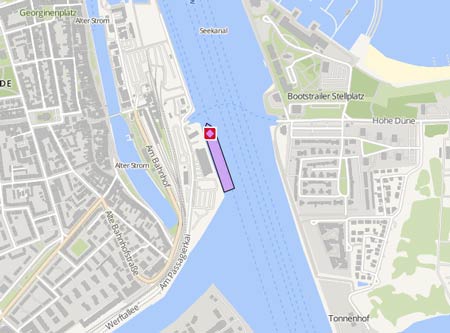EDMY
Kurs/Position
vor 4 Min
Die letzten Häfen
Die letzten Wegpunkte
Die neuesten Nachrichten
Report into collision published
The Norwegian Safety Investigation Authority has published its report on the collision between the 'Edmy' and the fishing vessel 'Tornado' in the Langesunds Bay on Oct 4 at 7 a.m. The ‘Edmy’ had left the port of Larvik bound for Copenhagen with a pilot on board until she reached Langesund Bay. The navigator was aware that they were in a fishing area, and observed AIS signals from a few smaller vessels on the radar. No vessels were observed in the vicinity that would conflict with the planned course. The navigator then turned his attention to a computer placed aft in the wheelhouse to carry out administrative tasks. They had plenty of time before they were due to arrive in Denmark, but the navigator wanted to finish this work as soon as possible. The ship had a bridge navigational watch alarm system installed, but it was not activated when the incident occurred. It was stated that the system was only used in the evening and at night. After half an hour on the same course, the navigator suddenly felt something hit the bow of the ship, and then saw the mast of a fishing vessel along the starboard side. It was the ‘Tornado’ which was trawling for prawns in Langesundbukta bay with two persons on board. They used both navigation lights and day shapes for trawling. The AIS was set to passive mode during the night to conceal the vessel’s position, as the exact location of fishing grounds was considered trade secrets. AIS transmission was activated 5–6 minutes before the collision occurred. The crew had just stopped trawling and started hauling the trawl at 08:28. It was around that time that the skipper noticed the cargo ship coming towards them, but he perceived it as part of the normal traffic in the area. The skipper considered calling the cargo ship over the VHF, but did not think it was necessary, as it was daylight and visibility was good. The crew continued hauling the trawl with the engine in forward gear. In reality, however, due to currents in the water and because they were being pulled towards the trawl while hauling, the vessel was moving backwards at a speed of around one knot. After a while, the skipper observed the cargo ship approaching, but assumed that she would pass without any risk of collision. When he realised that they were going to collide, he set the engine to full speed astern, but was unable to avoid impact. The collision caused the fishing vessel to lean to the side, and her course was turned almost 180 degrees. Once clear of the cargo ship, the fishing vessel still had propulsion, and the crew were able to turn her in the right direction. The crew were unharmed and proceeded to check the status of the vessel. She had sustained considerable damage to the port bow bulwark. The forward cargo hold was also checked, but no damage was observed. The skipper therefore continued the hauling process, as they had only had time to haul about 100 metres of wire and had 600 metres left. After the collision, the navigator reduced the speed of the cargo ship, turned the ship around, called the fishing vessel on VHF and asked whether they needed assistance. The navigator was asked to stand by, but to keep a safe distance because of the fishing gear. The sequence of events that appears in the first part of this report describes a situation where active navigation was not carried out over a period of time. NSIA has chosen to focus on some of the contributing factors to the accident. This is to highlight factors that NSIA believe provide the most universal safety learning. The navigator of the cargo ship checked the radar for potential dangers, without identifying the fishing vessel. The NSIA believes this was because the fishing vessel was only shown on the radar as an echo, with no AIS information on the radar or ECDIS displays. Use of navigational aids such as ECDIS and AIS allows navigators to rely more on the technology and thereby engage less actively in traditional outlook-based navigation. The NSIA believes that the expectation that most vessels transmit AIS information can lead to a false sense of security, as there is a possibility that not all dangers are identified. The bridge navigational watch alarm system is a tool that can help navigators to maintain attention over time. The system was deactivated on the cargo ship during the day, and the NSIA believes that the system would have contributed to safer navigation had it been active, because then the navigator had to acknowledge the alarm at the navigation instruments at the front of the wheelhouse. The NSIA experience fishermen’s wish to not transmit their position via AIS and thereby risk revealing their fishing grounds, but by not doing so, they also remove an important digital safety barrier by not enabling other vessels to identify them. Although visibility was good and the fishing vessel was clearly visible with day shapes and navigation lights, active AIS transmission at an earlier stage would probably have increased the likelihood of the cargo ship identifying the fishing vessel. Full report: https://safety4sea.com/wp-content/uploads/2022/12/NSIA-Collision-between-Edmy-and-Tornado-2022_12.pdf
Propulsion trouble in Ceuta
The "Ezaro" suffered propulsion failure on July 4, 2017, in Ceuta when leaving port. The ship was able to return to the port facilities despite the breakdown. The chief engineer detected a problem in the oil valve and it was decided to wait in Ceuta for the arrival of the technicians for repairs. On July 5 at 5.50 p.m. the ship finally sailed, bound for Essag, ETA July 7. Spanish report with photo: http://elfarodeceuta.es/2017/07/05/atracado-muelle-espana-buque-tras-sufrir-una-averia-la-bocana/
News schreiben

